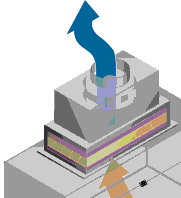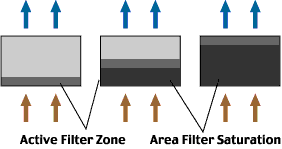Learn More: Ductless Exhaust Hoods
Ductless Fume Hoods: An Alternative to Laboratory Exhaust Systems
Exhaust Fume Filtration

Activated charcoal, the most common purification filtration medium, adsorbs chemicals with a molecular weight above 30 and a boiling point above 60°C. Carbon filters are also effective with many other chemicals because of their particular molecular structure.
Adsorption takes place in the active filter zone, the small cross-section of the filter bed in which the material to be removed comes in contact with the filtering medium. This active filter zone moves upward as the filter becomes saturated (see illustration). When it reaches the filter's top surface, there is an initial breakthrough by the contaminant gas; thereafter the percentage of contaminant gas that escapes filtration increases until total saturation of the filter is reached.
Ductless fume hoods manufactured by Terra use activated carbon filters to eliminate most nuisance fumes and can be used in conjunction with HEPA filtration. For more hazardous chemicals like strong acids and bases, specialized Labconco filtered fume hoods can be equipped with a wider range of filters and include an array of safety sensors for breakthrough detection.
Enhancing Filter Performance

To optimize filtration efficiency, any ductless exhaust fume system must ensure that the exhaust stream is exposed to the purification medium for an adequate time. Terra exhaust purification systems satisfy this condition in several ways.
First, our specially selected impeller ventilators are designed to ensure the optimal linear velocity of the airstream—sufficient to maintain a negative pressure in the work area that prevents backflow, but low enough to allow adequate adsorption of fumes by the filtering medium. Our pre-filters also extend exposure time by reducing the airflow through the filter.
Monitoring Filter Effectiveness
A ductless exhaust fume system needs to be monitored in two areas. The user must detect the period between initial contaminant breakthrough and the point at which the contaminant gas reaches the Threshold Limit Value (TLV) for that substance. The velocity of the airstream must also be monitored to ensure an adequate negative pressure and to detect ventilator failure.
Through periodic testing of the exhaust airstream, you can determine the useful filter life in your particular application and gauge filter effectiveness with an elapsed time meter.
An electronic airflow velocity monitor also helps users ensure safe, effective operation and provides an alarm when velocity falls below a user-defined threshold.
Put Safety First!
Avoid filter use in applications involving very toxic substances, very high volumes of contaminants, and unknown or highly volatile chemical reactions. Always make sure that filters are promptly changed when the Threshold Limit Value (TLV) has been reached for any contaminant gases present.
